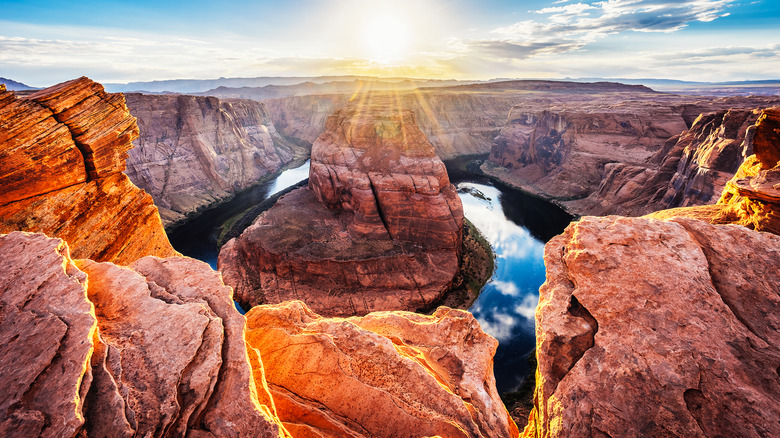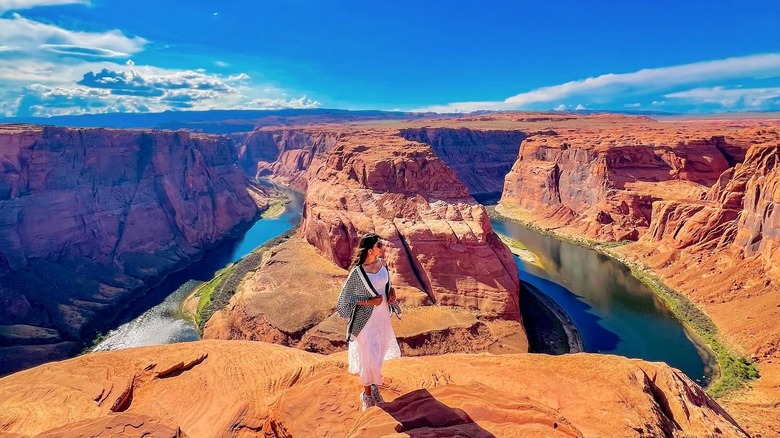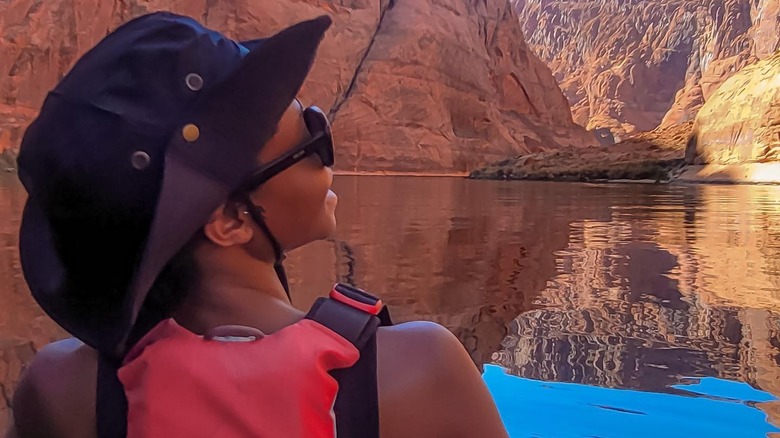One Of The Most Photographed Destinations In Arizona Is A Mesmerizing Natural Wonder
Believe the hype: Horseshoe Bend really is all that. This singular natural wonder leaves nearly all of its 2 million annual visitors gasping in awe. A semi-circular section of a 1,000-foot-deep canyon along the Colorado River, set between Lake Powell and the Grand Canyon, this easily accessible attraction might sound too "touristy" for hardcore outdoors enthusiasts, but even if the parking lot is thronged when you arrive, don't even think of skipping it. As one TripAdvisor visitor wrote, "Despite the crowd, the sight was unforgettable."
Photographers will especially love this setting, and those looking to best capture the sweeping vista will want to shoot wide-angle while bringing the ideal tripods to frame their shots and take incredible selfies. A protected viewing area was constructed in 2017, but the most photogenic spots do not have railings. If you have a fear of heights, approaching the cliff's uneven edge can be a challenge, and if you have kids who are a little too bold, that can be nerve-wracking, too. While not as dangerous as the Grand Canyon's Bright Angel Trail, people have plunged to their deaths, so don't be that backwards-walking selfie-taker.
As spectacular as Horsehoe Bend is, it's a fairly compact viewpoint, so you could be in and out in as little as an hour or two, making it a great addition to an itinerary that includes other sights in the Glen Canyon Recreation Area, like Antelope Canyon, a magical slot canyon on Navajo lands that's accessible by private tour only.
Seeing Horseshoe Bend in the very best light
The crowds at Horseshoe Bend peak between 9-11 am and 4:30 to 6:30 pm, with fewer visitors choosing to brave the hottest part of the day (temps can top 100 degrees in July). However, the main reason to visit early or late isn't to avoid the heat, but to see Horseshoe Bend at its best. At sunrise and sunset, the canyon stages an ever-changing, dynamic light show, best seen when the slanting light at dawn or dusk paints the striated red rock faces in shimmering shades of pink and gold, with skies to match.
If you want to be an early bird, grab a hotel in Page, Arizona, less than 10 miles away, and you can be at the rim by the time the sun breaks over the canyon's horizon. A dawn viewing will also help you avoid the summertime heat, which you'll definitely encounter even on a sunset visit. Veteran hikers might be tempted to think the 1.5-mi round-trip hike is easy-peasy, but the heat can be serious, which is why bright-colored signs warn you to carry water and wear the best possible hats for extra protection. But this isn't just a summer excursion — some of Horseshoe Bend's most breathtaking moments happen on cloudy days at sunset.
Getting an even better look at Horseshoe Bend
If gazing down at that perfect semi-circle of river has you longing to get out on the water, there are ways to do that. If you only have a couple of hours, you can take a 4-mi kayak trip with a shuttle. The water is all flat, so there are no rapids to contend with, and Lazy Otter Outfitters equips their kayaks with tracking devices, so whether you dart through quickly or meander along, they'll be there to meet you as soon as you finish. A 10-mi, half-day rafting tour will take in stunning petroglyphs too.
If you're adventurous and enjoy settings that offer thrills for the more experienced outdoors enthusiasts, you can even spend the night in the canyon on a trip with an outfitter, or DIY it by having an outfitter drop you upriver at the campsite right at Horseshoe Bend. There, you can wave to the sunset watchers up top right from camp, and then sleep under the stars before rising early for a gentle 9-mile downstream kayak trip (take a break at mile six at Waterholes Canyon to hike up a slot canyon).


